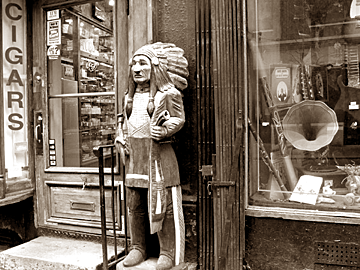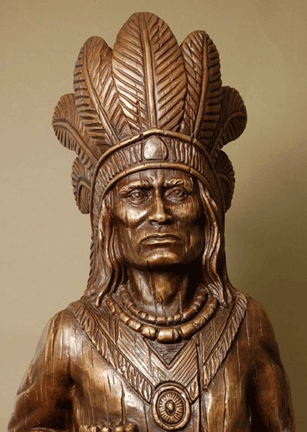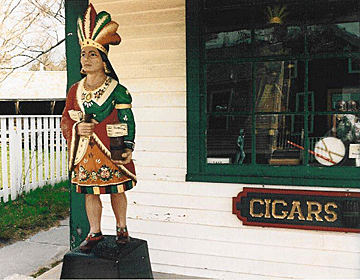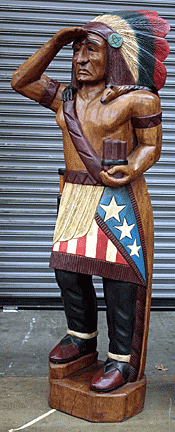|
Greetings to the World of
Tobacco
by Bob Brooke
 Cigar-store
Indians, with their serious chiseled faces, conveyed a sense of grandeur
as they greeted customers. Designed to capture the attention of
passersby, most of whom in the 19th century lacked a shared common
language, the sidewalk wooden Indian became a symbol of the tobacco
retail business. Because American Indians introduced tobacco to the
Europeans as early as the 17th century, European tobacconists began
using figures of American Indians to advertise their shops. Cigar-store
Indians, with their serious chiseled faces, conveyed a sense of grandeur
as they greeted customers. Designed to capture the attention of
passersby, most of whom in the 19th century lacked a shared common
language, the sidewalk wooden Indian became a symbol of the tobacco
retail business. Because American Indians introduced tobacco to the
Europeans as early as the 17th century, European tobacconists began
using figures of American Indians to advertise their shops.
How It All Started
While some shop figures were countertop models, most of these silent
greeters stood just outside the door, often mounted on wheels so that
they could be rolled in and out. The origin of the wooden Indian dates
back to England in 1617, when tobacco shop owners placed small wooden
figures called "Virginie Men," depicted as black men wearing headdresses
and kilts made of tobacco leaves, on countertops to represent tobacco
companies.
Eventually, the European cigar-store figure began to take on a more
authentic yet highly stylized appearance, and by the time these figures
arrived in America in the late 18th century, they had become authentic
Indians, fairly accurate and beautifully carved.
The Carvers
 Carvers
of these shop figures came from among the makers of ship figureheads.
During the late 19th century, the demise of the clipper ship era forced
figurehead carvers out of business. These craftsmen gradually turned to
producing wooden Indians. Production flourished from about 1840 to the
end of the century. In the 1890s, city ordinances required that figures
be confined to the interiors of shops, and gradually the statues went
out of use. Instead of attracting customers on the outside, they served
as mere decoration inside. Carvers
of these shop figures came from among the makers of ship figureheads.
During the late 19th century, the demise of the clipper ship era forced
figurehead carvers out of business. These craftsmen gradually turned to
producing wooden Indians. Production flourished from about 1840 to the
end of the century. In the 1890s, city ordinances required that figures
be confined to the interiors of shops, and gradually the statues went
out of use. Instead of attracting customers on the outside, they served
as mere decoration inside.
While a few makers produced cigar-store Indians of cast iron, most used
wood. Carvers used axes, chisels, and mallets on white pine or even
quartered ships’ masts, then painted the completed figures in a variety
of colors and designs.
While some of these wooden Indians appeared inviting, happily greeting
customers, others appeared defensive, as if guarding the store from
shoplifters, thieves, and "no smoking" ordinances.
American carvers sculpted Indian chiefs, braves, princesses and Indian
maidens, sometimes with boarded papooses. Most of these displayed some
form of tobacco in their hands or on their clothing. They generally
depicted stereotypical chiefs and squaws, clothed in fringed buckskins,
draped with blankets, decorated with feathered headdresses, and
sometimes shown holding tomahawks or bows, arrows and spears. Their
facial features rarely resembled members of any particular American
Indian tribe.
 Female
wooden Indians, also known as “Pocahontas,” appeared four times more
than their male counterparts in classical or Egyptian-inspired poses.
Carvers occasionally donned them with headdresses of tobacco leaves
instead of feathers and dressed their male figures in the traditional
war bonnets of the Plains Indians. Female
wooden Indians, also known as “Pocahontas,” appeared four times more
than their male counterparts in classical or Egyptian-inspired poses.
Carvers occasionally donned them with headdresses of tobacco leaves
instead of feathers and dressed their male figures in the traditional
war bonnets of the Plains Indians.
As marketing sign-posts, cigar-store Indians were meant to appear fresh
and welcoming. Sculptors applied brightly colored paints using
soft-bristle brushes, producing a look and feel of satin with an almost
translucent glow.
After weeks of labor, the figure would be ready and would be proudly
displayed outside the door of the shop. The more skillfully executed
ones attracted more viewers and many buyers.
Carvers produced about 300 cigar-store Indians annually—yet there are
relatively few original ones left today. Those that do exist reside in
museums and in private collections. Historians believe carvers created
over 100,000 cigar-store Indians. Since the carvers all competed with
each other for the tobacconists' business, each tried to out do the
other in individuality, versatility and depth. A few artists even used
Native Americans as models.
Styles of Carving
 Determining
the artistic integrity of a statue is as subjective as judging any piece
of sculpture. Each artist had his own unique style. Since most didn’t
sign their figures, cigar-store Indians can only be attributed to a
particular artist or his shop by identifying characteristic modeling
techniques or body positions. Determining
the artistic integrity of a statue is as subjective as judging any piece
of sculpture. Each artist had his own unique style. Since most didn’t
sign their figures, cigar-store Indians can only be attributed to a
particular artist or his shop by identifying characteristic modeling
techniques or body positions.
Thomas Brooks became known for his "leaners," wooden Indians resting
their elbows on log posts, barrels or oversized cigars. John Cromwell's
trademark was a distinctive V-shaped headdress. French Canadian Louis
Jobin tended to place his cigar-store Indians with their left arm at
chest level holding a robe and grasping a bundle of cigars in the right
hand.
The man who probably made more wooden Indians than anyone else was
Samuel Anderson Robb. After his first wife died, Robb began fashioning
sweet-faced Indian maidens holding roses similar to the kind he designed
for his wife's tombstone.
Some of these advertising sculptures, standing several feet tall up to
life-sized, were works of art, and as such fetch premium prices today.
Collectors determine the value of a cigar-store Indian by its condition,
the artistic integrity of its form, and the quality and intricacy of the
carving in that order. But the decisive factor is the condition of the
wood finish. Wooden Indians with their original paint are almost
impossible to find because itinerant painters repainted them on a
regular basis as routine maintenance.
And while cigar-store Indians may have faded into history, they haven’t
been forgotten.
<
Back
to More Antique Spotlights
Next Article > |
